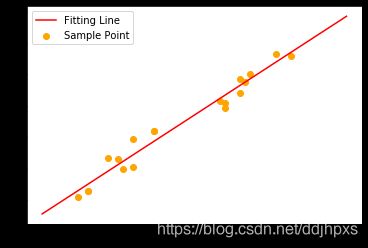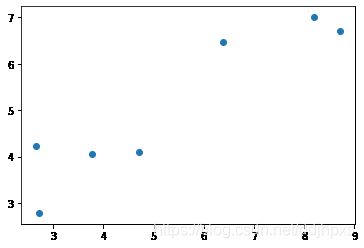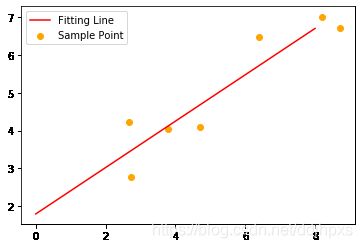写在前面:
笔记为自行整理,内容出自课程《数学建模学习交流》,主讲人:清风
拟合与插值的区别:
插值算法中,得到的多项式 f ( x ) f(x) f(x)要经过所有样本点。但是如果样本点太多,那
么这个多项式次数过高,会造成龙格现象。
尽管我们可以选择分段的方法避免这种现象,但是更多时候我们更倾向于得到
一个确定的曲线,尽管这条曲线不能经过每一个样本点,但只要保证误差足够小即
可,这就是拟合的思想。 (拟合的结果是得到一个确定的曲线)
拟合曲线的确定:
设样本点为 ( x i , y i ) , i = 1 , 2 , . . . , n (x_i,y_i),i=1,2,...,n (xi,yi),i=1,2,...,n,找到一条曲线 y = k x + b y=kx+b y=kx+b,确定 k , b k,b k,b的值,使得拟合曲线与样本点最接近。

代码实现
import pandas as pd
import numpy as np
import matplotlib.pyplot as plt
np.set_printoptions(suppress=True)
x = np.array([8.19,2.72,6.39,8.71,4.7,2.66,3.78])
y = np.array([7.01,2.78,6.47,6.71,4.1,4.23,4.05])
plt.figure()
plt.scatter(x, y)

方法一:利用Scipy.leastsq进行拟合
from scipy.optimize import leastsq
def err(p, x, y):
return p[0] * x + p[1] - y
p0 = [1, 1]
ret = leastsq(err, p0, args=(x,y))
k,b = ret[0]
print('k=',k)
print('b=',b)
k= 0.6134953486733113
b= 1.7940925476610339
x1 = np.linspace(0,8,100)
y1 = k * x1 + b
plt.scatter(x, y, color="orange",label='Sample Point')
plt.plot(x1,y1,color='red',label='Fitting Line')
plt.legend()

方法二:利用sklearn进行拟合
from sklearn.linear_model import LinearRegression
reg = LinearRegression()
x2 = x.reshape(-1,1)
y2 = y.reshape(-1,1)
reg.fit(x2,y2)
LinearRegression(copy_X=True, fit_intercept=True, n_jobs=None, normalize=False)
reg.intercept_
array([1.79409255])
reg.coef_
array([[0.61349535]])
方法三:利用statsmodels进行拟合
import statsmodels.api as sm
x3 = x
y3 = y
X = sm.add_constant(x3)
est = sm.OLS(y3,X)
est2 = est.fit()
est2.summary()
OLS Regression Results
| Dep. Variable: |
y |
R-squared: |
0.863 |
| Model: |
OLS |
Adj. R-squared: |
0.835 |
| Method: |
Least Squares |
F-statistic: |
31.46 |
| Date: |
Sat, 25 Apr 2020 |
Prob (F-statistic): |
0.00249 |
| Time: |
12:50:56 |
Log-Likelihood: |
-5.9456 |
| No. Observations: |
7 |
AIC: |
15.89 |
| Df Residuals: |
5 |
BIC: |
15.78 |
| Df Model: |
1 |
|
|
| Covariance Type: |
nonrobust |
|
|
|
coef |
std err |
t |
P>|t| |
[0.025 |
0.975] |
| const |
1.7941 |
0.633 |
2.833 |
0.037 |
0.166 |
3.422 |
| x1 |
0.6135 |
0.109 |
5.609 |
0.002 |
0.332 |
0.895 |
| Omnibus: |
nan |
Durbin-Watson: |
3.087 |
| Prob(Omnibus): |
nan |
Jarque-Bera (JB): |
0.717 |
| Skew: |
0.291 |
Prob(JB): |
0.699 |
| Kurtosis: |
1.544 |
Cond. No. |
14.9 |


